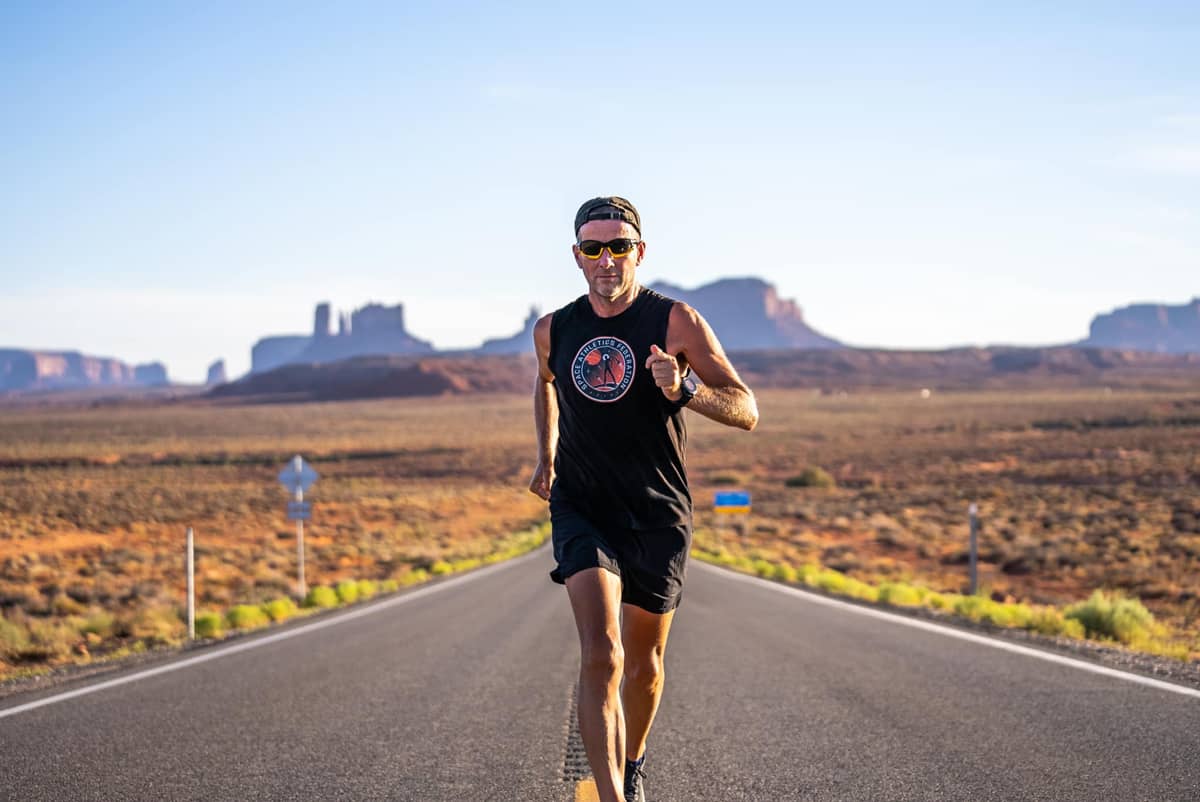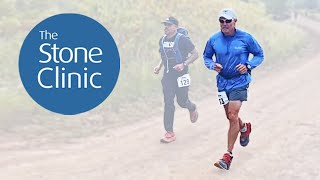Running After Knee Replacement
Hear From Our Patients
(Ultra) Running After Knee Replacement at 65Runners are addicted athletes. Even casual runners love the feeling and the benefits of the sport. When osteoarthritis gets so bad that a joint replacement is considered, the prospect of giving it up is one reason so many runners delay the procedure. But here’s what they don’t know: You don’t have to give it up.

Ultra runner and bilateral partial knee replacement patient Richard Donovan running down Forrest Gump Highway as part of his 3200+ mile cross country run. Photo courtesy of Richard Donovan.
Arthritis of the knee often presents with pain, loss of motion, and swelling. While the causes are many, the most common—post-traumatic arthritis—involves a past injury. Years ago, there was damage to the meniscus (which acts as a shock absorber) and the knee, which gradually wore off the articular cartilage (the weight-bearing surface) and collapsed the normally protected joint to bone-on-bone. Other causes, such as osteoarthritis (which is sometimes hereditary) or an inflammatory disease, can produce similar symptoms.
Running on healthy knees does not produce arthritis. The normal knee joint is designed to last a lifetime or two. Once damage occurs, though, the altered mechanics of instability and increased shock absorption can lead to progressive wear. If treated early, the injured tissues—such as the meniscus, ACL, and articular cartilage—can be repaired, regenerated, and replaced, protecting the joint.
Even after arthritis has set in (as long as there is still some space preserved between the bones) biologic joint replacement often returns athletes to competitive sports—including running. In this BioKnee technique, the meniscus and ligaments are replaced with donor tissue, and the articular cartilage is repaired. We almost always prefer a biologic joint replacement to an artificial one, as the biologic knee feels more normal and can always be revised to an artificial one at a later date.
When the knee joint is worn down to bone-on-bone, a partial or full knee replacement is usually required. With the advances in robotic technology and 3D modeling, these are now outpatient procedures with high accuracy and durable materials. For full joint replacement, the accuracy is so high that the need for bone cement is often eliminated: The body grows its own bone into the porous undersurface of the implants, fixing them permanently to each other. The question then becomes, why not run?
In the old days, patients were told to go home and rest their knee after artificial joint replacement. They could walk, play golf, and possibly play some doubles tennis. The fear was that the implants would either wear out or break down the cement that was fixing them to the bone. Unfortunately, this advice both depressed runners and led to a higher rate of bone osteoporosis and muscle weakening. Joint loosening and failure may have been increased by this “conservative” advice. By advising patients to return gradually to running, we build bone density and muscle strength—thereby decreasing the risk of joint loosening. The plastic inserts now used are so durable that there is a very low likelihood of them wearing out. And if they do, they can be relatively easily replaced.
However, most people—by the time they have succumbed to a joint replacement—have already been limping for years. They’ve lost their normal gait patterns, and have weaknesses in their hips and gluteal muscles. Their bodies have compensated with altered running and walking mechanics. It takes months of intense fitness training, preferably under the guidance of skilled trainers and physical therapists, to restore optimal body mechanics. While the bone healing into the undersurface of the implants is mostly complete after six weeks, the rest of the body usually requires four to six months of training before running is safe. Our patients start with gait training, core fitness, weightlifting, Pilates programs, pool running, balance training, and a host of other clever exercises before they return to outdoor running.
And it is safe. We have people running for fun, and running for extreme competitions like Ironman, Escape from Alcatraz, and similar events. In 30 years of fitness guidance, we have yet to see an artificial implant worn out from running—and with the newer techniques and materials, we believe the likelihood of this remains low. The chance of inviting depression by keeping a runner tied to a bike alone, however, is high. As the expression goes, “If you love someone, set them free.” This is especially true if they are a runner.
You may not need an artificial knee replacement. Often we find that patients have been told they need a knee replacement when they could, in fact, benefit from a less invasive procedure. Our BioKnee® program biologically reconstructs the knee joint without the use of artificial implants. Head here to learn about our alternative to knee replacement.
Hear From Our Patients Who've Returned to Running
Our robotic partial knee replacement patient and ultra runner Richard organizes and participates in one-of-a-kind long-distance races in awe-inspiring locations. One year after his second of two partial knee replacements, Richard embarked on the remarkable run across the continental United States.
He started his TransUSA Run at the Boston Marathon in April and finished 3,200 miles and 16 states later at the Santa Monica Pier in California. Running 40+ miles per day on his partial knee replacements was a phenomenal accomplishment and an absolute inspiration to injured athletes everywhere. You may find run photos and news articles on Richard's run here.



